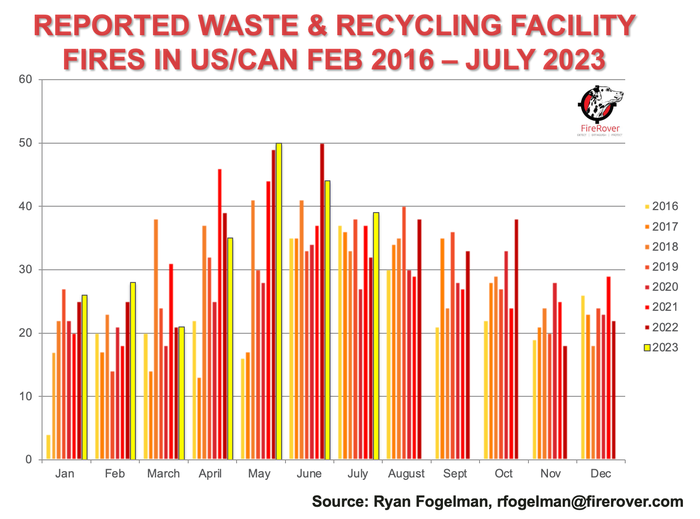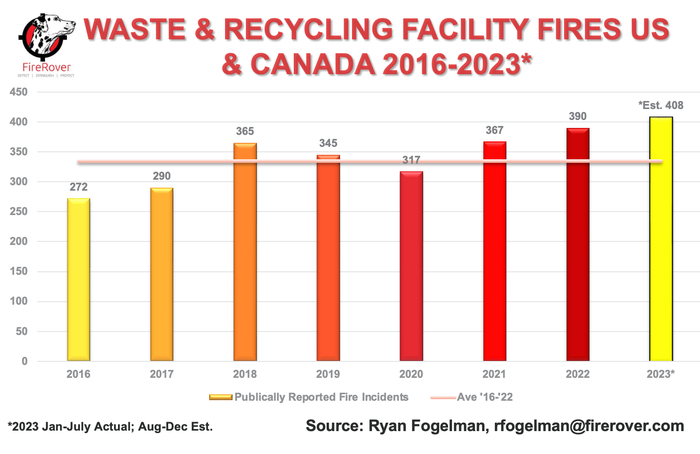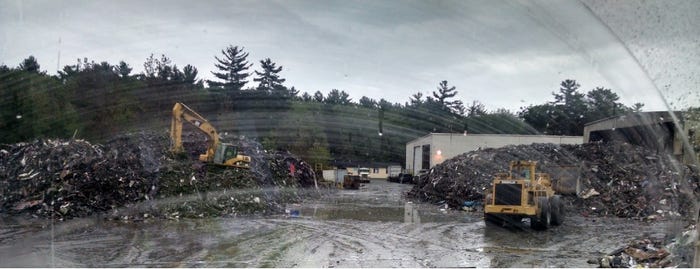Waste and Recycling Fire Report: Achieving the Best Case from a Worst-Case Scenario
With all the focus the waste and recycling industry has put into its fire prevention efforts, why are fire incidents in waste and recycling facilities still increasing?

With all things being equal, I am proud of the waste and recycling industry. The industry’s attitude toward fire is night and day compared to when I first started down this path in 2015.
Back then, “fire” was a dirty word not to be mentioned outside the four walls of any waste and recycling business. If there was a fire, fingers pointed to the operations and safety organizations to fix the operational breakdown that must have occurred.
Fast forward to today, and most waste and recycling companies have embraced fire prevention. Most organizations have some sort of plan in place or, at the very minimum, have begun to address the issue through planning, training, public education and investment in technology. As I addressed in last month's article, “Holy Smokes! Should We Allow “Bad” Operators to Operate?" the operators that haven’t taken action to prevent fires are continuing to be pressured by insurance companies, environmental agencies and the public to do so.
So, that begs the question: With all the focus the waste and recycling industry has put into its fire prevention efforts, why are fire incidents in waste and recycling facilities still increasing?
July 2023 Fire Data
In July, we hit another record, as we encountered 39 publicly reported fire incidents at our waste and recycling facilities. Of those incidents, 23 occurred in waste, paper and plastic facilities, nine occurred at scrap metal recycling facilities, three occurred at organics sites, two occurred at hazmat recycling facilities and one occurred each at an electronics recycling operation and a rubber recycling operation. At Fire Rover, we responded to 400-plus hot spots and/or fire incidents at our clients’ facilities.

As you can see from the data, last year we were fortunate to see a bit of a reprieve in July, but the relentless heat, along with the continuing increase of lithium-ion batteries in our waste stream, has made 2023 a year for the record books.

In the first seven months of this year, we have seen records, or close to records, in five of the seven months.

Unfortunately, when we look at annual reported waste and recycling facility fire incidents, 2023 is forecasted to end higher than our record-breaking 2022, 2021 and 2018 years. This is scary for the fact that we currently protect almost 500 waste and recycling facilities with our Fire Rover technology. Although our solution is not perfect, we have never had a catastrophic loss start in an area we protect, which is most of the newsworthy fires that are reported by the media.
The Fire Department Can Not Be Your First Line of Defense
I said this last month, but it is worth repeating: It is unacceptable to demand that your fire department be the first line of defense for these businesses. There are 1.2 million firefighters in the U.S. today, and most of them serve on a voluntary basis and receive limited training. They are professionals, but no fire department wants to fight these fires. They are already faced with enough dangerous hazards, including dealing with an electric vehicle or lithium-ion battery fires on an increasing basis, so they certainly don’t need to be engaged to fight a fire when it's not 100% necessary.
Fire Brigades Can Be Extremely Effective When Properly Organized
Along with investments in fire safety, sprinklers and technologies like Fire Rover, some companies have successfully employed fire brigades to deal with their fires. For example, at ReSource Waste Services, a construction and demolition operator in New England, David “The Captain” DeVito, is one of the leaders of fire prevention. As a veteran operator of waste and recycling operations and the current vice president of operations at ReSource Waste Services, he knows the importance of safety and fire prevention efforts.
I refer to DeVito as “The Captain” for several reasons, the first being that he has a passion for boats, and the second being that he has built a loyal and close-knit team that is willing to trust in the decisions he makes, which is critical when organizing a fire response team. DeVito firmly believes that the key to a successful fire brigade is that “the response time is the difference between control and chaos.” This mindset has led his drive along with the age-old Ben Franklin adage, “By failing to prepare, you are preparing to fail.” This is DeVito’s approach to developing, organizing, training and deploying a fire brigade.
Step #1: Develop a Fire Action Plan:
Have an emergency contact list of local police and fire departments.
Coordinate contingency planning walkthroughs with the local fire department.
Offer training for employees.
Ensure proper pile separation and accessibility.
Develop health, safety and environmental procedures and controls.
Ensure local employees for quick response are on call for accurate and up-to-date information.
Maintain a healthy combination of the right fire technology and equipment.
Step #2: Work with the Local Fire Department:
Conduct a site walkthrough with the local fire chief to assess hazards and essential equipment and structures.
Have an updated site plan that marks hydrants and other water sources, including equipment placement of compressed air foam systems and Fire Rovers.
Understanding and updating documentation of different types of materials and piles.
Having environmentally friendly fire suppression agents and equipment onsite to assist.
A great working relationship with the local fire department will ensure confidence that your team is competent in handling the situation.
Step #3: Employee Training:
Basic firefighter techniques and prevention.
Fire characteristics and stockpile monitoring.
Stockpile management and separation of burning materials.
Enlisting certified firefighters in the training of these employees promotes the critical aspect of their involvement.
Step #4: Accessibility:
Ensure proper segregation of piles and maintain proper lanes between piles.
Have multiple attack points.
Have open workable spaces.
Make sure equipment is parked away from piles.
Combustible tanks should be clearly marked and kept away from piles.
Step #5: On the Day of the Event:
Establish a command center.
Air monitoring equipment should be worn by all those in the affected area.
Attack piles from as upwind position if possible.
Visibility is very low, and the use of radios for communication is key.
Areas will become flooded and impassable.
Control sediment and water runoff by damming up drainage areas.
Putting the Fire Training into Action
All of DeVito and his team's hard work and planning came into play on a fateful day in 2015 at LL&S in New Hampshire. Employees closed the facility at 6 p.m. ET. A local resident noticed the smoke and glow emanating from the facility and called the fire department at 8:30 p.m. ET. The local fire department arrived and upgraded the call to a 4-alarm fire.
Emergency contacts were notified, and a command center was established. The LL&S fire brigade arrived at 9 p.m. ET, when the fire was upgraded to a 5-alarm. A site assessment was done with the LL&S fire brigade and fire chief to discuss and implement a course of action.

Working side by side with fire crews, we were able to move and separate material to extinguish the flames. The fire was contained and under control by 11 p.m. ET.

Throughout the night, LL&S and the fire department continued to separate material and search for hot spots.

After 13 hours and close to 800,000 gallons of water, the fire chief called the scene and dubbed it all clear at 9:30 a.m. ET. All fire departments and the LL&S fire brigade reported no injuries, no building damage, no monitoring wells issues and loss of only one day of operations.

Conclusion
As I said at the beginning of this article, I am proud of the waste and recycling industry. We are facing an uphill battle as we continue to see new fire hazards emerge. During our conversations, DeVito mentioned to me that “the major difference between the hazards we are seeing today versus the hazards that he was dealing with in 2015 is the onslaught of lithium-ion batteries in all commodities of our waste and recycling streams.” The fact is we cannot do without the power of lithium-ion batteries, nor can we do without the critical utility of our waste and recycling infrastructure across the globe. The only thing that is crystal clear to me is that we all need to continue to work together to educate, train and fight these fires with everything we have including operational best practices, technology and public education.
Ryan Fogelman, JD/MBA, is vice president of strategic partnerships for Fire Rover. He is focused on bringing innovative safety solutions to market, and two of his solutions have won the distinguished Edison Innovation Award for Industrial Safety and Consumer Products. He has been compiling and publishing the “Reported Waste & Recycling Facility Fires In The US/CAN” since February 2016 and the “Waste & Recycling Facility Fires Annual Report.” Fogelman regularly speaks on the topic of the scope of fire problems facing the waste and recycling industries, early detection solutions, proper fire planning and early-stage fire risk mitigation. Additionally, Fogelman is on the National Fire Protection Association’s Technical Committee for Hazard Materials. (Connect with Ryan on LinkedIn at https://www.linkedin.com/in/ryanjayfogelman or email at [email protected])
About the Author(s)
You May Also Like




